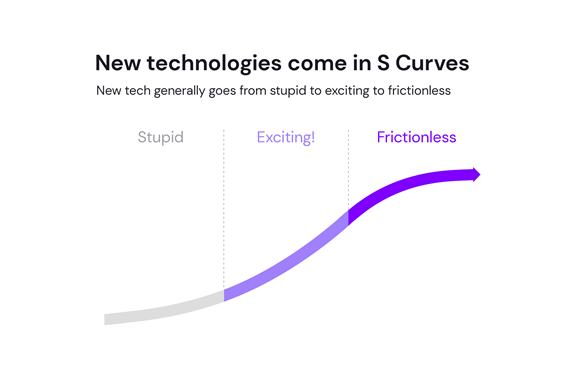Throughout the last 50 years, new technologies have entered our lives and captured our attention with a predictable trajectory. As Benedict Evans illustrated in his Tech in 2020 report, each new generational technology’s adoption follows an S-Curve passing from stupid, to exciting, and ultimately to boring:

Intelligent Customer Experiences: Using data to eliminate customer friction

As the Smartphone nears saturation and is leveling off in the boring zone, Evans wonders “What is the next S-Curve?”. While he ultimately lands on regulation and policy adjacent to tech, rather than on a new technology itself, the question “What’s next?” provides us a starting point to explore how intelligence and data can help renew excitement in seemingly familiar experiences and create entirely new opportunities for customers across channels, and how Kin + Carta can help.
Rethinking "the Boring Zone"
The plateau of this cycle can be, and often is, boring for users. Games go in and out of favor. Shopping apps get installed and uninstalled. Many of these experiences become bland and don’t improve. As consumers, we’ve had most of our favorite apps installed on our smartphones for years and others a decade or more. Facebook’s iPhone app was released to the app store in 2008, Spotify in 2009, and Uber in 2011. Most users, however, wouldn’t classify any of these 3 apps as “boring”. For many, they’ve become essential in their daily lives for communicating with friends, enjoying music, and getting to wherever they need to be. What differentiates these experiences is that they have leveraged data to build world-class experiences and continue to find innovative ways to use data so that they are now seamlessly integrated into our lives. These intelligent experiences have become frictionless.

Turning Data into Frictionless Experiences
Today, data is being captured at accelerating rates. The IDC estimates that by 2025 the average internet-connected person will have over 4,900 digital data engagements per day. That means that, on average, we will be giving over information every 18 seconds in the form of clicks, searches, purchases, friend requests, voice interactions, and in ways that haven’t even been invented yet. While that amount of data may sound paralyzing, at Kin + Carta we see it as the land of opportunity for customer experience.
For companies with the right perspective and the right framework in place, this data can be massively useful in building frictionless products, as it is with the examples provided above. We don’t need to look at the top of the app store charts to see this in practice though. Take TGI Friday’s, for example. In 2018, TGIF began leveraging customer order patterns in the app to surface up suggestive notifications and put the right order in front of customers in their times of need. For moms who take their kids home from soccer practice every Tuesday night at 7:30, family dinner is now surfaced to them automatically and is one click away. With 65 percent of notifications converted into orders, it’s clear that by leveraging this data TGI Friday’s has created an experience for customers that is seamless, simple, and smart.
Frictionless Natural Language
To bring it back to the original question, “What is the next S-Curve?”. Many believe that natural language is a potential frontrunner, and with good reason. It’s projected that 50 percent of all searches will be via voice by the end of 2020. Even with this increase in adoption (the excitement zone), how can consumers have the best possible experience via natural language experiences? The key, once more, is data.
No one has fully cracked a data-based frictionless voice or chat experience yet, but many companies are innovating in the space. Domino’s virtual assistant, Dom, is an omni-channel ordering agent that helps Domino’s drive 65 percent of all order traffic through their digital channels. Domino’s certainly isn’t alone in the quick service restaurant industry, with Starbucks, Chipotle, Dunkin, and others announcing or releasing voice-based experiences.
At Kin + Carta, we’ve worked tirelessly with our clients and our partners to explore ways to leverage data and build revolutionary experiences. With Google, specifically, we’ve partnered to help companies create new communication channels with customers on top of Dialogflow. We’ve reinvented the customer experience for call centers and have changed mental models on how to order your favorite food. To some, these efforts may seem original, but as we’ve shown in our work with Google, when experiences begin to use customer data we can remove the friction of tapping a mobile app, calling a human, or waiting in a drive-thru line. We are now confident that with the right customer experience expertise, the right tools, and the right data, retail and many other industries have begun reshaping how customers communicate with brands.
Frictionless Search
Despite our familiarity with search, little has changed in decades, and many efforts still fall far short of customer expectations. Search is another massive opportunity to use data and improve an existing technology that may seem standard and boring to many. Customers expect to be able to engage today in natural language and also ask questions, not just see results which match the search terms. Providing the same search results to all customers, regardless of what interactions we’ve had with a given experience, fails to take advantage of rich data. This leaves the burden on the user to sift through results and find exactly what they were looking for, even if they’ve found it in the past, introducing unnecessary friction.
Take Instacart, for example. Instacart users, on average, will make 20 searches per basket before they checkout. To make the most out of each search, Instacart leverages data from its broad user base and data specific to the user doing their shopping. By getting the results right, Instacart is making the more intuitive cart addition channel (search) more frictionless for its customers, and feeding data back into its own engine to continuously improve results.